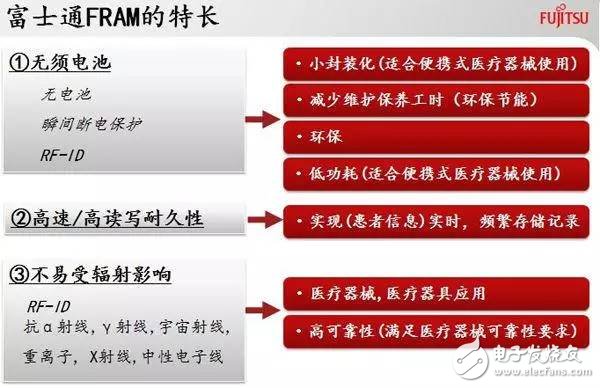Traditional memory such as flash memory and EEPROM uses charge injection to realize data storage, while FRAM uses external electric field to generate polarization to realize data storage. Therefore, it is less prone to alpha ray, x ray, gamma ray than traditional memory. The influence of heavy ions and other rays. People working in hospitals often see syringes equipped with electronic tags. Surgical instruments are sterilized with gamma rays and are resistant to electronic tags with built-in FRAM (non-volatile random access memory) that illuminate doses up to 50 kGy. We can be sure that high-reliability FRAM is one of the few electronic products for high-end medical applications.
"In fact, compared to traditional memory, FRAM is not only resistant to radiation, high speed / high read / write durability (more than one trillion times) and low power consumption is also his best memory choice for medical applications. Important reasons." Matsumoto Masahiro, Vice President of System Memory Division of Fujitsu Semiconductor Co., Ltd. said this in an event that made a special trip from Japan to Shenzhen.

FRAM (Ferroelectric Random Access Memory) combines the non-volatility of flash and E2PROM, and the high-speed, random-storage features of SRAM, bringing a unique set of advantages to stand-alone memory chips and embedded memories. Fujitsu pioneered FRAM technology and has been working in this field for more than 10 years. Since 1999, it has been mass-produced. By 2013, it has sold 2.3 billion FRAM products, of which 53 million were delivered in the Chinese market.
Although in the past five years, some new non-volatile memory technologies such as FRAM, PRAM, ReRAM, and MRAM have emerged, only FRAM has achieved excellent market mass production performance. Excluding some low-end applications, FRAM excels in applications that require non-volatile, high reliability, high security, high speed write, low power, high read and write endurance and radiation resistance. Good reputation. In the medical field, FRAM is particularly attractive for applications such as ventilators and other important high-end applications.
Masahiro Matsumoto also shared the current status of FRAM in the medical field: "Although FRAM is currently commercially available in the medical field, it is still in its infancy from a broad perspective. Compared to the Japanese and European markets, FRAM is in China. Market awareness needs to be improved, and Fujitsu Semiconductor will increase its investment in medical applications in the future to help more Chinese medical device manufacturers solve their data storage challenges."
The following figure highlights the three key benefits of FRAM for medical applications, where the battery-free features make it particularly suitable for portable medical devices, while reducing equipment maintenance costs; high speed/high read/write durability The patient information can be stored in real time and frequently; the anti-radiation characteristics meet the requirements of high reliability of medical devices.

Compared with traditional non-volatile memory such as EEPROM, Fujitsu FRAM's advantages are mainly high-speed programming (40,000 times EEPROM), high durability (1,000,000 times EEPROM) and low power Consumption (1/1,000 of EEPROM) and other aspects. These advantages make FRAM increasingly used in applications that require high reliability, such as meters (three-phase meters and water meters, gas meters, etc.), power automation, medical devices and medical electronic tags, automotive after-loading equipment, POS machine / financial ATM machine and so on.
In addition to being able to replace EEPROM in some applications, FRAM is more important to implement features not possible with EEPROM in some key medical applications. For example, in the fields of medical and biological treatment involving CT scan X-rays, ultraviolet rays for sterilizing, and gamma rays, as described above, FRAM is highly resistant to radiation. FRAM-based RFID can easily pass standard medical sterilization processes, and EEPROM-based RFID data information can be destroyed during this process.
For the cost of FRAM, Masahiro Matsumoto also stated his point: "This is related to storage capacity, different capacity, different prices. Now the price difference between FRAM and EEPROM is 2 to 5 times, and in terms of large capacity. For example, the price difference between FRAM and EEPROM of 1M to 2M is only 1 to 2 times. Therefore, in high-capacity applications, the price of EEPROM is not dominant, and will be replaced by FRAM in the future."
On the other hand, Fujitsu Semiconductor can guarantee the high quality and stable supply of FRAM products by controlling the overall development and mass production and assembly procedures of FRAM and years of experience. Fujitsu Semiconductor continues to innovate in low-power manufacturing processes to further reduce cost and size. The manufacturing process of EEPROM has not changed for a long time, and the cost advantage of EEPROM will gradually weaken over time.
“Excluding very low-end applications in the low-end applications, FRAM has 100% application in high-end medical equipment that requires high reliability, high-speed/high-endurance data reading and writing, low power consumption, and radiation resistance.†Song Gong Zhengren pointed out .
GALOCE Canister Load cells are an integral part of a weighbridge, and must act as durable mounting hardware to facilitate the harshest of outdoor environments. Weightron offer two models of stainless steel weighbridge Load Cell,which are based on the same mechanical envelope with key design features ensure optimum performance, precision and long-term durability.
Canister Load Cell,Tank Weighing Load Cells,Tank Load Cells,Tank Scales Load Cells
GALOCE (XI'AN) M&C TECHNOLOGY CO., LTD. , https://www.galoce-meas.com